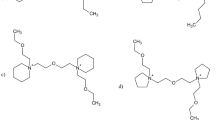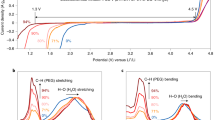Abstract
Super-concentrated water-in-salt electrolytes make high-voltage aqueous batteries possible, but at the expense of high cost and several adverse effects, including high viscosity, low conductivity and slow kinetics. Here, we observe a concentration-dependent association between CO2 and TFSI anions in water that reaches maximum strength at 5 mol kg−1 LiTFSI. This TFSI–CO2 complex and its reduction chemistry allow us to decouple the interphasial responsibility of an aqueous electrolyte from its bulk properties, hence making high-voltage aqueous Li-ion batteries practical in dilute salt-in-water electrolytes. The CO2/salt-in-water electrolyte not only inherits the wide electrochemical stability window and non-flammability from water-in-salt electrolytes but also successfully circumvents the numerous disadvantages induced by excessive salt. This work represents a deviation from the water-in-salt pathway that not only benefits the development of practical aqueous batteries, but also highlights how the complex interactions between electrolyte components can be used to manipulate interphasial chemistry.

This is a preview of subscription content, access via your institution
Access options
Access Nature and 54 other Nature Portfolio journals
Get Nature+, our best-value online-access subscription
$29.99 / 30 days
cancel any time
Subscribe to this journal
Receive 12 print issues and online access
$259.00 per year
only $21.58 per issue
Buy this article
- Purchase on Springer Link
- Instant access to full article PDF
Prices may be subject to local taxes which are calculated during checkout






Similar content being viewed by others
Data availability
All the data generated or analysed during this study are included in this article and its Supplementary Information. The details of the molecular dynamics simulation are available in Supplementary Data 1. Source data are provided with this paper.
References
Li, W., Dahn, J. R. & Wainwright, D. S. Rechargeable lithium batteries with aqueous electrolytes. Science 264, 1115–1118 (1994).
Suo, L. et al. “Water-in-salt” electrolyte enables high-voltage aqueous lithium-ion chemistries. Science 350, 938–943 (2015).
Luo, J.-Y., Cui, W.-J., He, P. & Xia, Y.-Y. Raising the cycling stability of aqueous lithium-ion batteries by eliminating oxygen in the electrolyte. Nat. Chem. 2, 760–765 (2010).
Yamada, Y. et al. Hydrate-melt electrolytes for high-energy-density aqueous batteries. Nat. Energy 1, 16129 (2016).
Yang, C. et al. Aqueous Li-ion battery enabled by halogen conversion–intercalation chemistry in graphite. Nature 569, 245–250 (2019).
Sun, W. et al. A rechargeable zinc-air battery based on zinc peroxide chemistry. Science 371, 46–51 (2021).
Wu, X. et al. Reverse dual-ion battery via a ZnCl2 water-in-salt electrolyte. J. Am. Chem. Soc. 141, 6338–6344 (2019).
Abbas, Q. et al. Strategies to improve the performance of carbon/carbon capacitors in salt aqueous electrolytes. J. Electrochem. Soc. 162, A5148–A5157 (2015).
Liu, Q. et al. 2.2V high performance symmetrical fiber-shaped aqueous supercapacitors enabled by “water-in-salt” gel electrolyte and N-doped graphene fiber. Energy Storage Mater. 24, 495–503 (2020).
Yoshio, H., Katsuhei, K., Akira, M. & Shin, S. Production of methane and ethylene in electrochemical reduction of carbon dioxide at copper electrode in aqueous hydrogencarbonate solution. Chem. Lett. 15, 897–898 (1986).
Tomita, Y., Teruya, S., Koga, O. & Hori, Y. Electrochemical reduction of carbon dioxide at a platinum electrode in acetonitrile-water mixtures. J. Electrochem. Soc. 147, 4164–4167 (2000).
Chen, Y.-T., Chen, H.-Y., Chien, Y.-S., Chuang, M.-C. & Chen, P.-Y. An excellent anode renders protic ionic liquids sustainable in metal electrodeposition. Green Chem. https://doi.org/10.1039/C9GC04169A 2020.
Huang, Q. & Lyons, T. W. Electrodeposition of rhenium with suppressed hydrogen evolution from water-in-salt electrolyte. Electrochem. Commun. 93, 53–56 (2018).
Pasta, M., Wessells, C. D., Huggins, R. A. & Cui, Y. A high-rate and long cycle life aqueous electrolyte battery for grid-scale energy storage. Nat. Commun. 3, 1149 (2012).
Wu, X. et al. Diffusion-free Grotthuss topochemistry for high-rate and long-life proton batteries. Nat. Energy 4, 123–130 (2019).
Wessells, C., Ruffο, R., Huggins, R. A. & Cui, Y. Investigations of the electrochemical stability of aqueous electrolytes for lithium battery applications. Electrochem. Solid State Lett. 13, A59–A61 (2010).
Winter, M. The solid electrolyte interphase – the most important and the least understood solid electrolyte in rechargeable Li batteries. Z. Phys. Chem. 223, 1395–1406 (2009).
Wood, S. M. et al. Predicting calendar aging in lithium metal secondary batteries: the impacts of solid electrolyte interphase composition and stability. Adv. Energy Mater. 8, 1801427 (2018).
Cheng, D. et al. Unveiling the stable nature of the solid electrolyte interphase between lithium metal and LiPON via cryogenic electron microscopy. Joule 4, 2484–2500 (2020).
Li, W. & Dahn, J. R. Lithium-ion cells with aqueous electrolytes. J. Electrochem. Soc. 142, 1742–1746 (1995).
Suo, L. et al. How solid-electrolyte interphase forms in aqueous electrolytes. J. Am. Chem. Soc. 139, 18670–18680 (2017).
Zhao, M., Song, X., Wang, F., Dai, W. & Lu, X. Electrochemical performance of single crystalline spinel LiMn2O4 nanowires in an aqueous LiNO3 solution. Electrochim. Acta 56, 5673–5678 (2011).
Wang, G. J. et al. Electrochemical behavior of LiCoO2 in a saturated aqueous Li2SO4 solution. Electrochim. Acta 54, 1199–1203 (2009).
Liu, X.-H., Saito, T., Doi, T., Okada, S. & Yamaki, J.-I. Electrochemical properties of rechargeable aqueous lithium ion batteries with an olivine-type cathode and a NASICON-type anode. J. Power Sources 189, 706–710 (2009).
Chen, Y., Freunberger, S. A., Peng, Z., Bardé, F. & Bruce, P. G. Li–O2 battery with a dimethylformamide electrolyte. J. Am. Chem. Soc. 134, 7952–7957 (2012).
Khurram, A., He, M. & Gallant, B. M. Tailoring the discharge reaction in Li-CO2 batteries through incorporation of CO2 capture chemistry. Joule 2, 2649–2666 (2018).
Yao, K. P. C. et al. Thermal stability of Li2O2 and Li2O for Li-air batteries: in situ XRD and XPS studies. J. Electrochem. Soc. 160, A824–A831 (2013).
Dong, Q. et al. Cathodically stable Li-O2 battery operations using water-in-salt electrolyte. Chem 4, 1345–1358 (2018).
Ding, M. S. & Xu, K. Phase diagram, conductivity, and glass transition of LiTFSI–H2O binary electrolytes. J. Phys. Chem. C 122, 16624–16629 (2018).
Frost, R. L. & Palmer, S. J. Infrared and infrared emission spectroscopy of nesquehonite Mg(OH)(HCO3)·2H2O–implications for the formula of nesquehonite. Spectrochim. Acta A 78, 1255–1260 (2011).
Nunn, P. B. & O’Brien, P. The interaction of β-N-methylamino-L-alanine with bicarbonate: an 1H-NMR study. FEBS Lett. 251, 31–35 (1989).
Abbott, T. M., Buchanan, G. W., Kruus, P. & Lee, K. C. 13C nuclear magnetic resonance and Raman investigations of aqueous carbon dioxide systems. Can. J. Chem. 60, 1000–1006 (1982).
Jakobsen, J. P., Krane, J. & Svendsen, H. F. Liquid-phase composition determination in CO2−H2O−alkanolamine systems: an NMR study. Ind. Eng. Chem. Res. 44, 9894–9903 (2005).
Fears, T. M. et al. Evaluating the solid electrolyte interphase formed on silicon electrodes: a comparison of ex situ X-ray photoelectron spectroscopy and in situ neutron reflectometry. Phys. Chem. Chem. Phys. 18, 13927–13940 (2016).
Dubouis, N. et al. The role of the hydrogen evolution reaction in the solid–electrolyte interphase formation mechanism for “Water-in-Salt” electrolytes. Energy Environ. Sci. 11, 3491–3499 (2018).
Jiang, L. et al. High-voltage aqueous Na-ion battery enabled by inert-cation-assisted water-in-salt electrolyte. Adv. Mater. 32, 1904427 (2020).
Huang, J. & Rüther, T. Why are ionic liquids attractive for CO2 absorption? An overview. Aust. J. Chem. 62, 298–308 (2009).
Cadena, C. et al. Why is CO2 so soluble in imidazolium-based ionic liquids? J. Am. Chem. Soc. 126, 5300–5308 (2004).
Tan, P. et al. Solid-like nano-anion cluster constructs a free lithium-ion-conducting superfluid framework in a water-in-salt electrolyte. J. Phys. Chem. C 125, 11838–11847 (2021).
Jorgensen, W. L., Maxwell, D. S. & Tirado-Rives, J. Development and testing of the OPLS all-atom force field on conformational energetics and properties of organic liquids. J. Am. Chem. Soc. 118, 11225–11236 (1996).
Canongia Lopes, J. N. & Pádua, A. A. H. Molecular force field for ionic liquids composed of triflate or bistriflylimide anions. J. Phys. Chem. B 108, 16893–16898 (2004).
McEldrew, M., Goodwin, Z. A. H., Kornyshev, A. A. & Bazant, M. Z. Theory of the double layer in water-in-salt electrolytes. J. Phys. Chem. Lett. 9, 5840–5846 (2018).
Berendsen, H. J. C., Grigera, J. R. & Straatsma, T. P. The missing term in effective pair potentials. J. Phys. Chem. 91, 6269–6271 (1987).
Zhu, A., Zhang, X., Liu, Q. & Zhang, Q. A fully flexible potential model for carbon dioxide. Chin. J. Chem. Eng. 17, 268–272 (2009).
Acknowledgements
All authors except K.X. acknowledge the support of the National Natural Science Foundation of China (51872322) and the Center for Clean Energy. J.Z., M.C. and G.F. thank the Hubei Provincial Natural Science Foundation of China (2020CFA093) and the Program for Huazhong University of Science and Technology, Academic Frontier Youth Team. K.X. thanks the Joint Center of Energy Storage Research, an energy hub funded by the US Department of Energy, Basic Energy Sciences, for support.
Author information
Authors and Affiliations
Contributions
L.S. and K.X. conceived the idea. J.Y. and L.S. designed the experiments. J.Y. performed the material preparation, electrochemical measurements and data analysis. L.J. performed the NMR measurements. Y.T. collected the TEM images, and L.L. measured the XPS spectra. T.L. performed the cost analysis of the electrolyte. J.Z., M.C. and G.F. performed the molecular dynamics simulations and analysed the data. J.Y., G.F., K.X. and L.S. wrote the manuscript. All authors discussed the results and commented on the manuscript.
Corresponding authors
Ethics declarations
Competing interests
The authors declare no competing interests.
Additional information
Peer review information Nature Chemistry thanks Jin Han and the other, anonymous, reviewer(s) for their contribution to the peer review of this work.
Publisher’s note Springer Nature remains neutral with regard to jurisdictional claims in published maps and institutional affiliations.
Supplementary information
Supplementary Information
Supplementary Figs. 1–39, Tables 1–3 and experimental details.
Supplementary Data 1
Bulk files for molecular dynamics simulation.
Source data
Source Data Fig. 1
Source data for the graph in Fig. 1.
Source Data Fig. 2
Source data for the graph in Fig. 2.
Source Data Fig. 3
Source data for the graph in Fig. 3.
Source Data Fig. 4
Source data for the graph in Fig. 4.
Source Data Fig. 5
Source data for the graph in Fig. 5.
Source Data Fig. 6
Source data for the graph in Fig. 6.
Rights and permissions
About this article
Cite this article
Yue, J., Zhang, J., Tong, Y. et al. Aqueous interphase formed by CO2 brings electrolytes back to salt-in-water regime. Nat. Chem. 13, 1061–1069 (2021). https://doi.org/10.1038/s41557-021-00787-y
Received:
Accepted:
Published:
Issue Date:
DOI: https://doi.org/10.1038/s41557-021-00787-y
This article is cited by
-
Rational design of anti-freezing electrolytes for extremely low-temperature aqueous batteries
Nature Energy (2024)
-
Design strategies for rechargeable aqueous metal-ion batteries
Science China Chemistry (2024)
-
Trend of Developing Aqueous Liquid and Gel Electrolytes for Sustainable, Safe, and High-Performance Li-Ion Batteries
Nano-Micro Letters (2024)
-
Designing electrolytes and interphases for high-energy lithium batteries
Nature Reviews Chemistry (2023)



